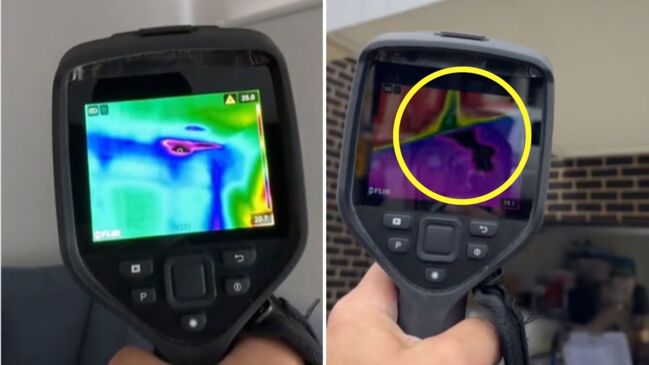Millions of Aussies sitting on ‘ticking time bombs’ as serious building defects become the norm
Written by admin on September 10, 2024
Millions of Australians are sitting on ticking time bombs that could detonate at any moment and those meant to prevent disaster are almost powerless to help.
New research from the Australian Housing and Urban Research Institute has revealed 70 per cent of the estimated 10.9 million homes across the country have some kind of major building defect.
They range from plumbing and waterproofing issues, some of which can cause hazardous mould, through to serious structural faults and foundation cracking.
Associate Professor Lyrian Daniel from the University of South Australia, an architectural expert and lead author of the research, said the findings smash the old perception that homes in this country are well-built to stand the test of time.
“For many years in Australia, we’ve had a fairly laissez-faire approach to regulation in the construction sector when it comes the quality of our housing,” Dr Daniel, said.
“The notion that the free market will demand a certain level of quality – it will lead to high standards – simply doesn’t ring true. We need national leadership in this area – a strategy that ensures housing stock, whether it’s new, existing, owned or private rental, is of a good standard.”
Zeher Khalil is a building inspector who checks the quality of new and recently constructed homes across the country, called in either before a development is handed over or when a property owner runs into issues.
Mr Khalil, founder of the firm Site Inspection, said it’s “pretty much a guarantee” he’ll find at least one serious defect in every dwelling he checks.
“We don’t categorise issues as minor or major – we look at whether the minimum Australian standards have been met,” Mr Khalil explained.
“That’s all we’re expecting – not that a (tradesperson) has gone above and beyond, but that they’ve done the bare minimum required of them. And I’m telling you, not many have. I see non-compliant defects 100 per cent of the time.”
And he’s not talking about a patchy paint job or some missing silicon.
“I’m talking about really serious issues that require the roof to be stripped out or an entire bathroom to be demolished,” he said.
Given around 150,000 to 170,000 new homes are built each year, that’s a lot of “ticking time bombs” that will go off sooner rather than later, he said.
“This country now builds homes that don’t even last for 10 years,” Mr Khalil said. “You get to year seven or eight and they’re falling apart.”
The issue is so bad that he not only found AHURI’s research unsurprising, but expected the number of homes with defects to be much higher.
“With a lot of new places popping up, I can tell looking from the street that there are issues. I don’t even need to go inside. I walk around and think, where’s the building authority?”
Mr Khalil shares clips to TikTok of the shonky work he encounters, earning some three million likes – and more than a few death threats.
“What I do upsets some people,” he said. “I’ve had a lot of threats from people in the industry who don’t like being exposes.”
Some of the worst cases he’s seen are so serious that someone could be injured or killed as a result of the defect, he said.
“I inspected a house in New South Wales recently where the entire roof on a completed home, a place someone was living in, had no braces on the roof trusses. It had been fully signed off.”
Aside from structural issues, including constant examples of foundation cracks, Mr Khalil said waterproofing and weatherproofing issues are common.
“Just this morning I was at an apartment in Collingwood. The bathrooms are non-compliant, the balcony too, which will now be a pretty serious headache (for the owner). That’s common,” he said.
It doesn’t matter whether it’s a stand-alone house, a small block of flats or a dense apartment complex – or whether the contractor is a small operator or a major builder – there are always issues at the end of construction, he said.
While he’s seen it all over the years, Mr Khalil still finds it hard to believe the sheer extent of problems given how much Australians pay for their homes.
“Last week, I was in Sydney and I inspected a home that was selling for $2.5 million,” he said. “Essentially the whole thing was noncompliance. Roofing, waterproofing, water going into the kitchen, guttering, leaks … you name it.
“That’s a minimum of $100,000 to correct. Someone will have to allow for that. It’s a huge problem. And when you’re building a new home, what are you meant to do – expect you’ll have to pay more on top to fix problems, or take the builder to court? It’s crazy.”
Authorities in Victoria have begun naming and shaming serious offenders in a bid to shock the industry into lifting its game.
The NSW Building Commission publishes a rolling list of work rectification orders it issues to builders and developers, which makes for sober reading.
A recent case saw the watchdog identify 54 serious defects in one of three buildings in the Kingston Quarter development in Meadowbank in Sydney’s northwest, which was built just four years ago.
The site at 20 Nancarrow Avenue, developed by Holdmark, has a litany of issues relating to fire safety, waterproofing, and structural faults.
Among them, evidence of cracking in the basement and on the 10th floor, as well as “uncontrolled cracking of a critical transfer beam supporting the upper floors” on level one.
Despite the issues, homes in the complex still command a pretty penny, with a two-bedroom unit recently selling for $875,000.
On the Lower North Shore, buyers in the Jacota complex at 9 Young Street in ritzy Neutral Bay have been plagued by problems since construction was completed six years back.
Among 30 different defects recently identified by the NSW Building Commission are serious breaches of federal building standards, with several relating to fire safety.
The rectification order also noted “significant cracking” in the main car park and “uncontrolled cracking of four millimetres and greater in the basement’s concrete slabs.
“Some cracks have migrated through the full depth of the basement slabs, with water penetrating through,” it warned.
In exclusive Vaucluse in the eastern suburbs, the bougie Amara development at 43 Captain Pipers Road, a boutique collection of four townhouses and two penthouse apartments, has issues with waterproofing that have led to significant dampness.
Its fire safety measures are also not up to scratch.
Experts conservatively estimate that half of all new apartment developments across NSW have at least one serious defect, but it’s not just units where issues arise.
Major home builder Frasers has been under fire after it emerged 92 per cent of properties developed in a new estate in Shell Cove on the state’s South Coast have some kind of defect.
The NSW Building Commission said the fact 325 of the 354 homes built since 2019 have issues, mostly to do with waterproofing, is “shocking”.
Some are so bad that affected residents are unable to occupy parts of their homes.
Frasers, a global conglomerate run out Singapore, has pledged to rectify all identified defects, but conceded it could take up to two years.
Those homeowners battling defects obviously face serious and long-running financial challenges in pursuit of justice and an adequate resolution.
But Dr Daniel said the consequences go much further than that.
“There are implications for people’s mental health and wellbeing while living with these issues, so depression and anxiety and so on,” she said.
“There are a whole range of health issues that arise from mould, whether it’s respiratory disease or the exacerbation of asthma.
“But I think it’s really worth remembering that it’s not just new builds, but existing homes as well.”
Other research conducted by AHURI found four out of five Australian homes are too cold during winter, according to international standards set by the World Health Organisation.
And those battling insufficient heating or defects that expose them to the elements often have few, if any means to rectify the problems.
Take renters in the private market, for example, who mostly have to put up with freezing homes.
“And we know that cold temperatures in homes can cause issues with cardiovascular health and respiratory health,” Dr Daniel said.
As Mr Khalil’s work across the country and the AHURI research show, the issue isn’t confined to Sydney and NSW.
Separate research commissioned by the campaign group Australian Apartment Advocacy found 60 per cent of new units have defects ranging from dangerous balconies and cracked foundations to chronic water leaks.
“In my view, the problem is so bad and so common because people have gotten away with it for so long,” Mr Khalil said.
More Coverage
Tradespeople who are pursued individually have tended to cop a slap on the wrist, while builders brought before a tribunal or taken to court by desperate owners have a tendency to shut up shop and cry poor.
Mr Khalil said regulators with teeth are needed, alongside serious penalties and long-term consequences for those who do the wrong thing.
Dr Daniel agreed but said real change will require national co-ordination, political courage, and the ability to resist the efforts of lobbyists.








